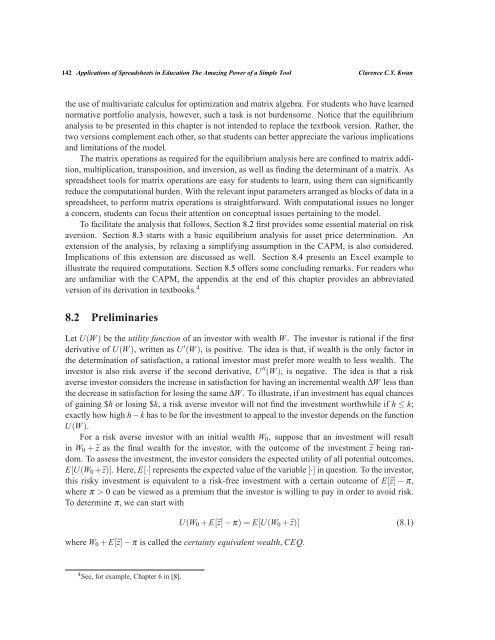chapter 3 - Bentham Science
chapter 3 - Bentham Science
chapter 3 - Bentham Science
Create successful ePaper yourself
Turn your PDF publications into a flip-book with our unique Google optimized e-Paper software.
142 Applications of Spreadsheets in Education The Amazing Power of a Simple Tool Clarence C.Y. Kwan<br />
the use of multivariate calculus for optimization and matrix algebra. For students who have learned<br />
normative portfolio analysis, however, such a task is not burdensome. Notice that the equilibrium<br />
analysis to be presented in this <strong>chapter</strong> is not intended to replace the textbook version. Rather, the<br />
two versions complement each other, so that students can better appreciate the various implications<br />
and limitations of the model.<br />
The matrix operations as required for the equilibrium analysis here are confined to matrix addition,<br />
multiplication, transposition, and inversion, as well as finding the determinant of a matrix. As<br />
spreadsheet tools for matrix operations are easy for students to learn, using them can significantly<br />
reduce the computational burden. With the relevant input parameters arranged as blocks of data in a<br />
spreadsheet, to perform matrix operations is straightforward. With computational issues no longer<br />
a concern, students can focus their attention on conceptual issues pertaining to the model.<br />
To facilitate the analysis that follows, Section 8.2 first provides some essential material on risk<br />
aversion. Section 8.3 starts with a basic equilibrium analysis for asset price determination. An<br />
extension of the analysis, by relaxing a simplifying assumption in the CAPM, is also considered.<br />
Implications of this extension are discussed as well. Section 8.4 presents an Excel example to<br />
illustrate the required computations. Section 8.5 offers some concluding remarks. For readers who<br />
are unfamiliar with the CAPM, the appendix at the end of this <strong>chapter</strong> provides an abbreviated<br />
version of its derivation in textbooks. 4<br />
8.2 Preliminaries<br />
Let U(W) be the utility function of an investor with wealth W. The investor is rational if the first<br />
derivative of U(W), written as U ′ (W), is positive. The idea is that, if wealth is the only factor in<br />
the determination of satisfaction, a rational investor must prefer more wealth to less wealth. The<br />
investor is also risk averse if the second derivative, U ′′ (W), is negative. The idea is that a risk<br />
averse investor considers the increase in satisfaction for having an incremental wealth ΔW less than<br />
the decrease in satisfaction for losing the same ΔW. To illustrate, if an investment has equal chances<br />
of gaining $h or losing $k, a risk averse investor will not find the investment worthwhile if h≤k;<br />
exactly how high h−k has to be for the investment to appeal to the investor depends on the function<br />
U(W).<br />
For a risk averse investor with an initial wealth W0, suppose that an investment will result<br />
in W0+z as the final wealth for the investor, with the outcome of the investment z being random.<br />
To assess the investment, the investor considers the expected utility of all potential outcomes,<br />
E[U(W0+z)]. Here, E[·] represents the expected value of the variable[·] in question. To the investor,<br />
this risky investment is equivalent to a risk-free investment with a certain outcome of E[z]−π,<br />
where π > 0 can be viewed as a premium that the investor is willing to pay in order to avoid risk.<br />
To determine π, we can start with<br />
U(W0+ E[z]−π)=E[U(W0+z)] (8.1)<br />
where W0+ E[z]−π is called the certainty equivalent wealth, CEQ.<br />
4 See, for example, Chapter 6 in [8].

















